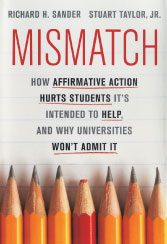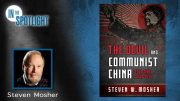
Mismatch: How Affirmative Action Hurts Students It’s Intended to Help, and Why Universities Won’t Admit It, by Richard H. Sander and Stuart Taylor, Jr., New York: Basic Books (a member of the Perseus Books Group), 2012, 348 pages, hard cover.
What do a hyper-liberal college professor, an extremely liberal journalist, and the U.S. Commission on Civil Rights agree upon? Present “affirmative action” programs meant to aid blacks in college do exactly the opposite — they hurt blacks. And the first two listed above present an abundance of facts to prove their point — including what happened at the Commission on Civil Rights — in their book Mismatch: How Affirmative Action Hurts Students It’s Intended to Help, and Why Universities Won’t Admit It.
As could be expected, the authors, Professor Rick Sander and journalist Stuart Taylor, aren’t against affirmative action per se, but they are against the status quo, because it doesn’t work as intended.
The authors are quick to point out that true affirmative action, which they define as “proactive efforts to prevent discrimination against minorities and promote genuinely equal opportunity by ensuring that selection procedures are fair and by using outreach and recruiting to correct past patterns of exclusion,” was, upon its inception, quickly overrun by “racial preferences.” Racial preferences, as they define them, are “programs that allocate college admissions or other opportunities based partly on the race of the candidate.” And it’s really these racial preferences that don’t work.
The reason the preferences don’t work is that they cause a “mismatch” between the skills and attitudes of the blacks admitted to college under such preferences and the speed and degree of difficulty of the classes that the blacks enroll in. Colleges essentially boost the credentials of black applicants as compared to the white and Asian applicants in order to obtain an acceptable number of black students. This results in black students being placed in classes that move too fast or that require background information that the black students don’t have.
To explain the authors’ point, I’ll use an example from my past. When I took my first college accounting class, that class moved so fast that we covered in two weeks all of the material that I had learned in a semester-long high-school accounting course. Without the foundation knowledge from that high-school course, I likely would’ve been so lost that I never would have passed the class. That’s what happens to mismatched blacks in college.
The authors note that this is not a negative reflection on the intelligence of blacks; it is just a logical consequence of the system.
The repercussions of the school/student mismatch are also logical to predict: black student panic and self-doubt, dropping out, changing career goals, and a perception by blacks and others that blacks “are inherently poor students.” Oftentimes, there is also substantial student debt, with no degree or career path with which to pay it off.
Of course, such claims require substantial documentation. And the authors provide it. The first story they tell is about what happened when California passed Proposition 209, which bans racial preferences in college admittance.
Anti-Prop. 209 activists claimed vociferously that banning racial preferences would mean that blacks and Hispanics would disappear at elite California schools, such as Berkeley and UCLA. And they were partially correct: The total number of blacks did plunge at the elite schools initially, but “the total number of black and Hispanic students receiving bachelor degrees was the same for the five classes after Prop 209 as for the five classes before.” (Emphasis in original.) So all those students who would’ve dropped out anyway didn’t have to suffer the humiliation and trials of failure, while those who would have succeeded anyway did succeed.
“As well, the drop in numbers of minorities at the schools was short-lived: “Strong black and Hispanic students accepted UCLA offers of admission at much higher rates after the preferences ban went into effect.”
Those blacks who were now denied admittance to UCLA because their SATs and school background showed them to be unqualified could then gain admittance to colleges where they were more likely to succeed. And the best of them could transfer to an elite school later.
In a similar scenario, the eight Ivy League schools had low percentages of black students graduating with degrees in science, technology, engineering, and math, despite the fact that prior to beginning college a higher percentage of them than whites planned to get such a major. Upon investigation, it was learned that the common denominator for those who dropped out of their preferred major was “weak academic preparation.” On the other hand, black students at many historically black colleges and universities — less rigorous schools — “were far more likely not only to get bachelor’s degrees in science but also to move on to doctoral programs.”
The findings of the Ivy League schools were corroborated by Frederick Smyth and John McArdle of the University of Virginia, who gained access to data on 28 colleges and found that “had all the black and Hispanic students in their sample enrolled at schools where their credentials were close to class-wide averages, 45 percent more of the women minorities and 35 percent more of the men minorities would have completed STEM degrees [Science, Technology, Engineering, and Math degrees].”
Despite the definitiveness of these studies, as well as other conclusive studies coming to the same finding, no colleges or professional publications or news media would cover the findings, or take them into account in the college admissions process. For various reasons academic elites across the nation believed it was better to continue subjecting blacks to failure, rather than address the obvious.
Yet, the authors learned, academic preparation is also a strong indicator of how well one will do in one’s field of choice, such as practicing law. Professor Sander learned while teaching at UCLA that law students who received racial preference admittance were much less likely to pass the bar exam and (if they did pass) do much more poorly at actually being a lawyer — and that the connection was so obvious that “all the big law firms looking for the students who would make the best trial lawyers and almost all the judges looking for the best law clerks placed so much weight on the LPGA [law school grades] of law students applying to them.”
To “remedy” this selectivity by employers, “UCLA, like most other law schools, refused to reveal the class rank of its students.”
By 1997, Sander had noticed that “about half of UCLA Law School’s black students were ending up in the bottom tenth of the class…. [And] low grades meant poor bar performance. The school’s first-time bar passage rates were about 50 percent for blacks … and 90 percent for whites.” And academic support could only “slightly improve outcomes.” Yet equally prepared blacks at less prestigious colleges “passed the bar 75 to 80 percent of the time.” Moreover, “the vast majority of minority law students would still be admitted to a selective law school (albeit a less elite one) if racial preferences suddenly disappeared.”
The authors note that other academics tried to blame test bias for poor black bar passage rates, but other analyses showed this wasn’t the case. The same mismatch effect happened for older white students who were also given preferences in law school admissions. “The larger the preferences were, the more severe the mismatch effect would be.”
For all of the angst and grief that racial preferences caused otherwise brilliant black students, the preferences only added about 14 percent more black students to law schools than there would have been without preferences — and the 14 percent added were weakly qualified to be there.
One fact that really makes the racial preferences a sin is that law students from elite schools generally make only a little more money than lawyers from less elite schools.
The book also covers other drawbacks of racial preferences, Supreme Court decisions affecting affirmative action (the Supreme Court clearly abandoned the rule of law for “fairness”), and what the authors think should be done to aid blacks and others. As a whole it is extremely convincing, loaded with studies both for and against mismatch theory so that one can judge for oneself the quality of the arguments, and is usually quite interesting and readable, though some parts become a bit tedious because of the numerous studies and the restatement of the same facts.
Ironically, even though the authors document thoroughly the almost complete dishonesty or willful ignorance of liberals in this debate, there is an undercurrent noticeable in the book that it is conservatives who are the extremists and liberals who are noble. The book also relies heavily on some assumptions, such as the assumption that whites and Asians aren’t really hurt by preferences. Another assumption is that early efforts to recruit blacks to college worked well, despite the fact that even these programs were so rigidly politically correct that college recruiters intentionally overlooked the brightest black students, under an incorrect assumption that high-performing students were the children of well-to-do parents and would succeed without help, as was documented by professor Thomas Sowell in his book Black Education: Myths and Tragedies.
The authors’ political leanings come through in spades in their recommendations of how to fix schools, kindergarten through college — often federal fixes that essentially have no chance of happening because of entrenched political interests by bureaucrats who caused almost all the problems in the first place — and wiser, but still unlawful, affirmative-action decrees from the Supreme Court.
Despite the book’s flaws, everyone who really does care about the welfare of blacks, and not just some political agenda, should read the book.



